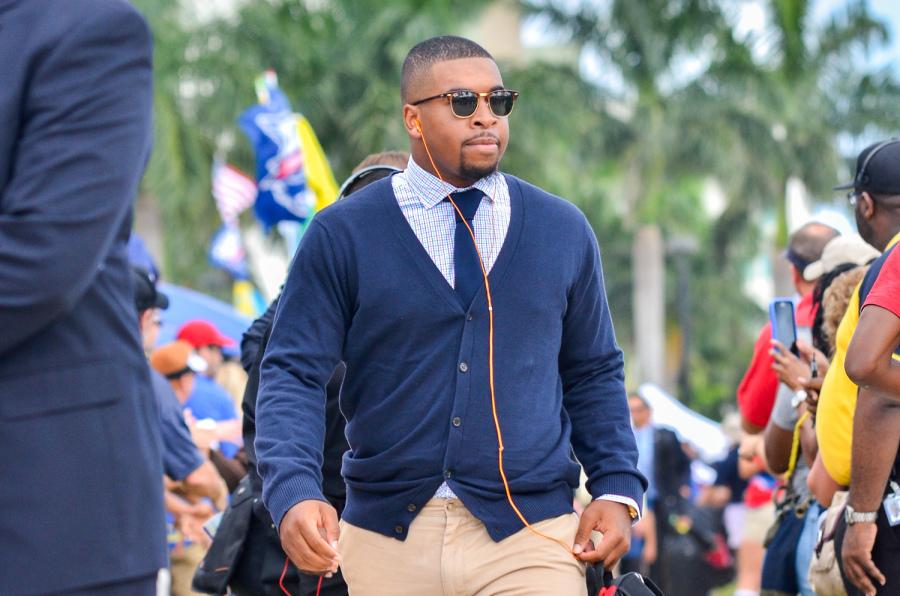Look Good, Play Well
Requiring the football team to dress nicely on game day has given them an incentive to win.
Quarterback Jaquez Johnson takes the Owl Walk before the Sept. 27 game against the University of Texas San-Antonio. Ryan Murphy | Business Manager
One of the first changes that Charlie Partridge made upon becoming head football coach took place off of the field — and in their closet. Players are required to dress business casual before their games.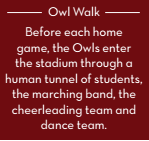
Should they win, players have the option of leaving in sweatpants. A loss means every player has to wear the business attire on the way home.
“There is just something about dressing up, you’re in a different mode. This is business now,” Patridge said of his rationale behind having players dress sharply.
His motivation goes back to his days at Iowa State. The night before a game versus Iowa, Partridge — an ISU graduate assistant at the time — and the staff dressed in suit and tie. “At the time, I was young. I didn’t want to put a tie on either,” he said.
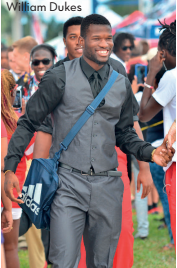
In their Cedar Rapids hotel was another team from a school that Partridge said was on either the Division 2 or Division 3 level of college football. They wore casual outfits, in stark contrast to Partridge and company.
“I saw their kids look at our kids, and they felt outclassed,” said Partridge of the other team staying in that hotel. Iowa State went on to defeat the rival Hawkeyes 24-14 on Sept. 16, 2000.
What a team wears during the pre and postgame portions of travel depends solely on the head coach. Some, like Kentucky’s Mark Stoops, require players to wear a suit and tie. Other college coaches, including Middle Tennessee State’s Rick Stockstill, require that players wear sweatsuits to and from games.
Stockstill played for college football coaching legend Bobby Bowden, who required that players wear a suit and tie on every game day. “ “You don’t risk guys all wearing different shirts, pants and some having holes,” the fifty-six year old former Florida State Seminole quarterback said. “It’s much neater and more professional all being dressed the same way.”
Southern Mississippi coach Todd Monken has his players wear school-issued polos and sweats, but went a step further than even Partridge.
Using money from the school’s Touchdown Club, Monken bought a suit for each of the graduating seniors — quite a classy gesture, especially given that those men were not his recruits.
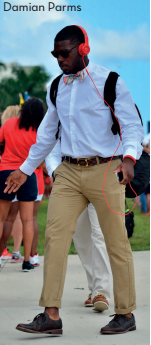
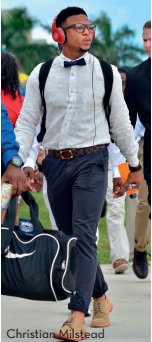
The 2013-2014 year was the first four with Monken as the USM head coach. The men who graduated were players who entered the program under former coaches Larry Fedora (2009-2012) or Ellis Johnson (2013 — fired after an 0-12 season).
“I wanted each of our guys to be able to have a suit for their first job interview. I don’t care if their first job interview is for an NFL team or they are going to work a nine-to-five job,” Monken said. “I felt like it was a way that I could give back to these young men and help them get their professional career, no matter what that happens to be, off on the right foot.”
Monken mentioned that many of his men had never owned a fitted suit before, and there is a similar dynamic on the FAU football team. Some men come from underprivileged backgrounds where they may not have been able to afford business casual clothing, and thus never learned how to appropriately don it.
Business attire is required in the bulk of the work world, and even simple tasks like tying a tie or finding the correct length for a pair of pants could work wonders in a future job interview.
“[There are] still people learning how to tie a tie,” said senior Christian Milstead.“You would be surprised. That’s what we have teammates for. The coaches help us out too.”
In August, FAU cornerback Cre’von LeBlanc was certain that he would have a shot at the NFL — and he wouldn’t entertain any other possibility. LeBlanc helps other teammates dress on game day if needed, and the junior cornerback mentioned dressing up as part of maintaining the focus that the team needs to have during weekends on the road.
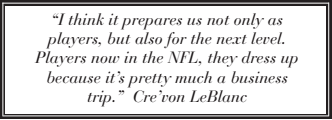 “I think it prepares us not only as players, but also for the next level,” he said. “Players now in the NFL, they dress up because it’s pretty much a business trip.”
“I think it prepares us not only as players, but also for the next level,” he said. “Players now in the NFL, they dress up because it’s pretty much a business trip.”
Professional leagues have dress codes of their own, too. David Stern grew unhappy with the “thug” image that he felt was attached to the NBA, so the now-retired commissioner instituted a dress code to try and present the players as upstanding citizens.
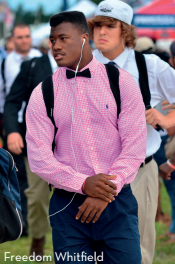
Players have taken the dress code requirements and run with it. You might’ve seen Dwyane Wade, Russell Westbrook or Paul George rocking some unique outfits during the last postseason. That stems back to Stern’s requirements — players have found ways to make their own statements while still following the rules.
The infrastructure of the NHL keeps players in line — hockey player Vincent Lecavalier remembers a suit and tie requirement when he was 10 years old. Every NFL team has rules on what players can wear when entering hotels and airports.
Two-time Super Bowl-winning head coach Tom Coughlin requires that his players have a suit and tie at all times on the road. While they don’t quite have the financial freedoms of your average professional athlete, the Owls seem to have embraced the new stipulation.
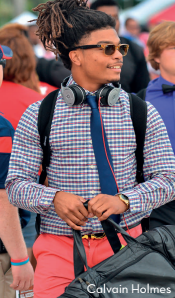
Wins aren’t exactly rolling in just yet, but players do appreciate the chance to see each other dressed nicely. Some choose to put dress clothes back on even after a win, opting to flaunt their style for journalists, photographers, and — of course — Instagram.
“I like it,” said senior receiver Lucky Whitehead of the tradition, adding that he prefers to keep his outfits relatively simple. “I like dressing up, for the team it’s like a fashion statement. You get to see who really gets to go all out.”
Quarterback Jaquez Johnson has worn pastel colors on several occasions, and is adamant about looking good for the cameras when the opportunity comes. “If I feel like i got some good clothes on, like I look good, I’m going to wear my clothes after a win,” he said. “That’s how I feel.”
Outside of himself, Johnson mentioned defensive backs Damian Parms and Christian Milstead as the best dressers on the team.
Time will reveal whether the old “look good, feel good, play good” adage rings true. At any rate, Partridge is teaching his players to dress and carry themselves like professionals do. That means more than a mere win ever could.
Marketing major
Previously: Sports writer, sports editor, editor in chief
Started as sports writer
Twitter: @NotEvenWes
Outside of journalism: African-American...
Ryan is a graduate student in the College of Science. He started in 2012 as a staff photographer and has since won several awards for his work at the UP....


